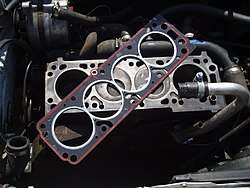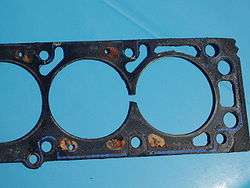Head gasket
A head gasket is a gasket that sits between the engine block and cylinder head(s) in an internal combustion engine.


Its purpose is to seal the cylinders to ensure maximum compression and avoid leakage of coolant or engine oil into the cylinders; as such, it is the most critical sealing application in any engine, and, as part of the combustion chamber, it shares the same strength requirements as other combustion chamber components.[1]
Types
- Multi-Layer Steel (MLS): Most modern head engines are produced with MLS gaskets. These consist of two to five (typically three) thin layers of steel, interleaved with elastomer. The contact faces are usually coated with a rubber-like coating such as Viton which adheres to the cylinder block and cylinder head while the inner layers are optimized for resilience.[2][3]
- Solid copper: a solid sheet of copper, and typically requires special machining called 'o-ringing'[4] that places a piece of wire around the circumference of the cylinder to bite into the copper. When this is performed copper gaskets are extremely durable. Recently companies have started producing copper gaskets with integral sealing wires,[5] permitting their retrofit into engines without the removal of the engine block for machine work.
- Composite: an older technology. Typically these are made from asbestos or graphite but are more prone to blowouts than newer gaskets. Asbestos gaskets are becoming increasingly rare due to health concerns.[6]
- Elastomeric: a gasket type used by Rover on their K Series engines. It used a steel core plate with molded in place silicone rubber beads to seal oil and coolant passages. The bores were sealed by rolled steel fire rings in a more conventional manner. The idea behind the gasket design was to produce a production version of the technology used in F1 engines at the time. The original application of the gasket on the smaller versions of the K Series was very successful. However, an engine redesign resulted in persistent problems with the design—the joint interface became unstable and the gasket could not cope.
O - Ring type head gaskets. Steel O – Ring and Copper O – Ring type gaskets are the strongest in their class. They are reusable and if used between correctly prepared flat surfaces will yield the highest clamp down possible due to their massive reduction in surface area. Most gaskets are designed, to do their job of sealing about 100bar cylinder pressure within each cylinder, and at the same time keeping oil (7bar @ WOT) and water (2bar @ WOT) from mixing.
Higher compression engines, either normally aspirated or some form of forced induction (when under boost) can require more work to ‘tune out’ DETONATION. Once detonation sets on, cylinder pressures and temperatures escalate rapidly. Pressures up to 8 times normal cylinder pressure, sometimes even more, cause the cylinder head to literally lift up leaving the cylinder head gasket unclamped.
Production gaskets will let go under these conditions every time, just like the example shown. It is important to note here that no engine should ever be run under these adverse conditions purposely, however during the ‘tuning’ period of many performance engines these severe conditions may be encountered for short periods, so it is vital to have a cylinder head gasket that can withstand brief bursts of detonation without letting go, so that further adjustments can be made to “tune out” any detonation spikes.
The cost of a replacement gasket is usually not extreme, but the price of total repair is significantly high. This is because the process of removing/replacing an engine head is very time-consuming—around 75% of cost will be labor. Furthermore, untreated blown gaskets usually seriously damage the engine, then requiring even more expensive work.
Gasket problems
The usual internal combustion engine is a water-cooled four-stroke gasoline design. It uses three circuits of working fluids:
- Combustible air/fuel mixture
- Water-based coolant, usually with glycol mixed
- Motor oil for lubrication
These are all vital, but must never be allowed to intermix. Apart from sealing the cylinder, the head gasket also seals water and oil conduits between the head and block. Any connectivity between them will cause engine failure, or significant problems like burning oil (smoke from the exhaust). Blue exhaust smoke may be indicative of oil burning. White exhaust smoke is an indicator of coolant burning, another sign of head gasket wear.
Occasionally, the compression in the cylinder will cause a leak to form in the gasket and the gasket will have to be replaced, or severe damage can take place (a "blown" head gasket). This problem has been exacerbated by the use of aluminum rather than iron cylinder heads; while lighter than iron, aluminum has a much greater thermal expansion rate, which in turn causes a great deal more stress to be placed on the head gasket. Engine makers have responded to this by adding a non-stick coating such as Teflon to the surface of the head gasket.
If the gasket fails, a variety of problems can occur, from compression loss (leading to power reduction, or a rough engine), to exhaust gases being forced into the cooling system, leading to the engine overheating and increased engine wear due to the motor oil being mixed with antifreeze. Coolant can leak into the cylinders, causing the exhaust to issue steam[7] and the catalytic converter to be damaged. If a very large amount of coolant does this, hydrolock can occur, causing extensive engine damage. Sometimes, all that may happen when a head gasket is blown is excessive steam erupting from the tailpipe; yet the engine may act and drive like normal, until all the coolant is gone and the engine overheats. In other occurrences compression leaks into small spaces between the gasket, and either the cylinder head or engine block traps air that is then released when the engine is turned off. The air then escapes into the coolant and creates air pockets. Sometimes these air pockets can get trapped in the engine's coolant thermostat, causing it to stay closed and cause further overheating, thereby creating still more voids between the gasket and the engine. Air pockets can also cause the engine to expel coolant into the overflow or expansion tank, thereby reducing the amount of coolant the engine has available to stay cool.

The condition of a head gasket is typically investigated by checking the compression pressure with a pressure gauge, or better, a leak-down test, and/or noting any indication of combustion gases in the cooling system on a water-cooled engine. Oil mixed with coolant and excessive coolant loss with no apparent cause, or presence of carbon monoxide or hydrocarbon gases in the expansion tank of the cooling system can also be signs of head gasket problems.
A good sign of head gasket failure on water-cooled engines is the presence of a substance that resembles mayonnaise in the oil, often to be seen on the dipstick, or oil filler cap. However, the presence of this substance is not conclusive proof of head gasket failure, since oil could mix with the coolant via other routes. Likewise, it is entirely possible for a head gasket to fail in such a way that oil never comes in contact with coolant. Because of this, oil that has NOT become contaminated with coolant should not be taken as a definitive sign that the head gasket is okay.
A leaking head gasket can be classified as either external or internal. An external leak can be identified as oil and coolant accumulating underneath the engine. The presence of coolant can be detected by shining a black light on what appears to be an oil leak; the appearance of coolant will show up under the black light. External leaks can also appear as previously described in the oil. An internal leak can usually be diagnosed by excessive coolant accumulating in the expansion tank along with the presence of hydrocarbons in the form of foam. The possibility of vapors or condensation and/or water (from the road or rain) building up (in aftermarket product installation) from an external breather or catch tank from the head (rocker cover) can also cause a buildup of froth or foam in the oil but is highly unlikely.
References
- Bickford, John H. (1997). Gaskets and Gasketed Joints. CRC Press. p. 57. ISBN 0-8247-9877-5.
- "Best Head Gaskets – Choosing the Right Gasket for you car". Auto Accessories Performance. 15 March 2017. Retrieved 2017-05-23.
- "Multi-layer Steel (MLS) Cylinder-Head Gaskets". Victor Reinz. Retrieved 2017-05-23.
- http://scegaskets.flywheelsites.com/wp-content/uploads/2014/02/Pro-Copper-HG-Inst.pdf
- http://scegaskets.com/wp_super_faq/ics-titan-head-gasket-installation/
- Nunney, M. J. (1998). Light & Heavy Vehicle Technology. Elsevier. p. 23. ISBN 0-7506-3827-3.
Since exposure to asbestos is now recognized as being a health hazard [...] the manufacture of non-asbestos cylinder head gaskets has now become established.
- Nunney, p. 23.
External links
| Wikimedia Commons has media related to head gaskets. |
- Ask's Head Gaskets and Valve Covers Q&A
- How to Repair Your Head Gasket - An example of how a head gasket was replaced.
- List of Best Head Gasket Sealers